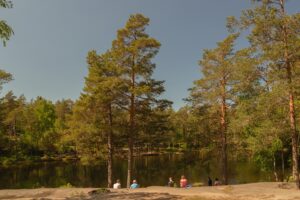Richmond Park: London’s Largest Royal Park
Richmond Park is a vast, enchanting green space located in the southwest of London. As the largest of the capital’s Royal Parks, it offers a serene escape from the bustling city life, providing visitors with a unique blend of natural beauty, wildlife, and history. Whether you’re a nature enthusiast, a history buff, or simply looking for a peaceful retreat, Richmond Park has something for everyone.
What to See and Do
Richmond Park is renowned for its stunning landscapes and diverse wildlife. One of the park’s most famous features is its population of over 600 free-roaming deer. These majestic creatures can often be seen grazing in the open fields, providing a picturesque scene that feels worlds away from urban London. The park is also home to a variety of other wildlife, including birds, rabbits, and foxes, making it a haven for nature lovers and photographers.
For those who enjoy walking or cycling, Richmond Park offers numerous trails and paths that wind through its 2,500 acres. The Tamsin Trail, a popular 7.35-mile circular route, is perfect for a leisurely walk or a more vigorous bike ride. Along the way, you’ll encounter ancient woodlands, open grasslands, and stunning views of the London skyline from King Henry’s Mound.
If you’re interested in horticulture, the Isabella Plantation is a must-visit. This 40-acre woodland garden is renowned for its vibrant displays of azaleas, rhododendrons, and camellias, particularly in the spring. The plantation is a peaceful spot to relax and enjoy the beauty of nature.
A Bit of History and Interesting Facts
Richmond Park has a rich history dating back to the 17th century. It was created by Charles I in 1637 as a deer park, and its primary purpose was to provide hunting grounds for the royal family. The park’s historical significance is evident in its ancient trees, some of which are over 700 years old, and its well-preserved landscapes.
One interesting fact about Richmond Park is that it is a National Nature Reserve and a Site of Special Scientific Interest. This designation highlights its importance in preserving biodiversity and protecting rare species of plants and animals. The park’s management focuses on maintaining its natural habitats while allowing public access, ensuring that it remains a cherished green space for generations to come.
Another fascinating aspect of Richmond Park is King Henry’s Mound, a historic viewpoint that offers a protected sightline to St. Paul’s Cathedral, 10 miles away. This view has been preserved for centuries, and visitors can enjoy the unique perspective through a telescope installed on the mound.
Getting There and Tips for First-Time Visitors
Richmond Park is easily accessible by public transport and car. If you’re traveling by train, the nearest stations are Richmond and Kingston, both of which are a short bus ride or a pleasant walk from the park. Several bus routes also serve the area, making it convenient for visitors coming from different parts of London.
For those driving, there are several car parks within the park, but they can fill up quickly, especially on weekends and public holidays. It’s advisable to arrive early to secure a spot. The park is open from 7:00 AM in the summer and 7:30 AM in the winter, closing at dusk.
First-time visitors should be aware that Richmond Park is a natural environment, so it’s important to respect the wildlife and follow the park’s guidelines. Keep a safe distance from the deer, as they are wild animals, and stick to designated paths to protect the park’s delicate ecosystems. Dogs are welcome but must be kept on a lead during the deer birthing season from May to July.
Whether you’re planning a leisurely stroll, a family picnic, or a day of exploration, Richmond Park offers a tranquil escape with plenty to see and do. Its combination of natural beauty, historical significance, and accessibility makes it a must-visit destination for anyone in London.








